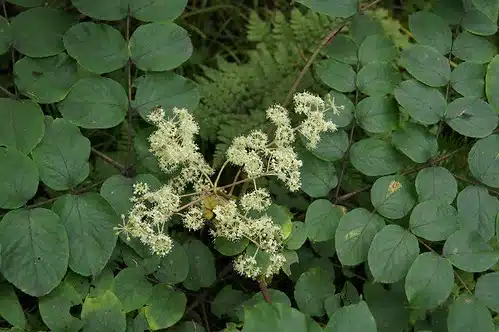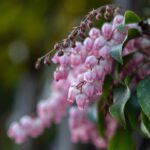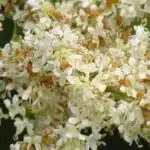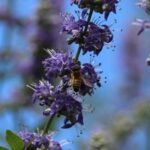Aralia elata, also known as the Japanese Angelica tree, is a deciduous tree that is native to Eastern Asia. This ornamental plant is highly valued for its unique beauty and medicinal properties. The Japanese Angelica tree can grow up to 10 meters in height and has a broad canopy with large, serrated leaves that turn golden yellow in the autumn.
Growing the Japanese Angelica tree requires some knowledge of its specific requirements. It prefers well-drained soil that is rich in organic matter and grows best in partial shade or full sun exposure. The plant can be propagated through seeds or cuttings, but it requires some attention when it comes to watering and fertilizing. In addition to its aesthetic appeal, the Japanese Angelica tree has been used for centuries in traditional medicine for its anti-inflammatory properties and is highly sought after by herbalists around the world. If you’re interested in growing this beautiful plant, then read on for some tips on how to cultivate your own Japanese Angelica tree at home.
Introduction To The Japanese Angelica Tree
The Japanese Angelica Tree, also known as Aralia elata, is a plant species that belongs to the family Araliaceae. It is native to Japan, Korea, and China’s northern regions and is known for its large size and stunning appearance. This deciduous tree can reach up to 15 meters tall and 8 meters wide, making it an excellent choice as an ornamental tree in gardens, parks, and streets.
The Japanese Angelica Tree has a unique growth pattern with multiple stems that form a rounded crown. Its bark is grayish-brown and covered with small bumps or lenticels. The leaves are compound, with 7-17 leaflets that are ovate in shape and serrated on the edges. During the summer months, this tree produces clusters of white flowers that resemble umbrellas. These flowers later give rise to reddish-black berries during autumn.
Apart from its aesthetic value, the Japanese Angelica Tree holds historical significance in Japan. It has been used for centuries in traditional medicine practices due to its purported health benefits. The roots, leaves, and stem bark of this tree contain several active compounds that have antiviral properties, aid digestion, reduce inflammation and prevent hypertension. Today it is still essential in traditional medicine practices but also used in the production of herbal teas and supplements worldwide. Understanding the plant’s requirements is necessary for successful cultivation; thus knowing how to grow a Japanese Angelica Tree can help you enjoy its beauty while benefitting from its medicinal properties.
Understanding The Plant’s Requirements
For successful growth of the Aralia Elata, it is essential to have basic knowledge about its planting techniques. The plant prefers a well-drained soil that is rich in organic matter and has a slightly acidic pH level. As this tree can grow up to 20 feet tall and 15 feet wide, it requires an area with enough space for its roots to expand. Therefore, it is advisable to plant this tree away from other plants or structures.
Assessing the growth rate of Aralia Elata is crucial for optimal care. It has a slow growth rate during its first few years after planting; however, it will start growing rapidly once established. Regular pruning can help maintain the desired shape and size of the tree while promoting healthy growth. Pruning should be done in early spring before new growth appears.
To ensure proper care for your Aralia Elata, consider choosing the right location and soil type. This tree thrives in partial shade to full sun conditions and needs adequate water supply during its establishment period. Moreover, it prefers fertile soil that is moist but not waterlogged. A good practice would be to add compost or organic matter such as leaf litter or bark chips into the soil before planting. In the subsequent section, we will discuss in detail about choosing the right soil and location for this plant to thrive without any inconvenience.
Choosing The Right Soil And Location
As with any living organism, the foundation of growth is in the soil. The Japanese angelica tree thrives in well-draining soil that is rich in organic matter. Think of it like a relationship – the soil provides the support and nourishment for the tree to grow, just as our loved ones provide us with emotional support and guidance. A healthy and happy tree begins with choosing the right soil composition.
When selecting an ideal location for your Japanese angelica tree, consider its natural habitat. In the wild, these trees typically grow in sunny areas near rivers or streams. Mimicking this environment will help ensure optimal growth and health for your tree. Think of it like finding your own personal happy place – a location that brings you peace and tranquility, similar to what a sunny spot near a flowing body of water provides for the Japanese angelica tree.
To make things easier, we’ve created a table outlining ideal soil pH levels and moisture content for growing the Japanese angelica tree:
| Soil pH Level | Moisture Content |
|---|---|
| 5.5-6.5 | Consistently moist but well-drained |
Remember that these are only guidelines; different regions may require slightly different soil conditions depending on factors such as climate and weather patterns.
Now that you know how to choose the right soil composition and location for your Japanese angelica tree, it’s time to learn about propagating this beautiful species.
Propagating The Japanese Angelica Tree
Aralia elata, commonly known as the Japanese Angelica Tree, is best propagated from seed or cuttings. It is important to note that the seeds need to be fresh and sown in moist soil for optimal growth. For propagation from cuttings, it is recommended to use semi-woody stems and to place them in the soil with a rooting hormone for best results. Pruning and care of the Japanese Angelica Tree is important for the overall health and growth of the tree. It is recommended to prune the tree regularly and to apply fertilizer in the spring and summer months. Furthermore, the tree should be monitored for pests and diseases, and appropriate control measures should be taken as necessary.
Planting From Seed
To propagate the Japanese Angelica Tree, planting from seed is a viable option. The germination process of the Aralia Elata can be tricky, but with proper care, one can have a successful yield. It is important to note that the seeds of this tree are typically slow to germinate and may take up to two months before showing any signs of growth.
To start the germination process, it is recommended to soak the seeds in water for 24 hours prior to planting. This will help soften the hard outer shell of the seed and allow moisture to penetrate more easily. Once soaked, plant the seeds in well-draining soil and keep them moist by misting them regularly. It is also important to ensure that they are kept in a warm environment between 75-80°F.
As the seedlings begin to grow, they require proper care to ensure their health and vitality. Transplant them into individual pots once they have reached about 2 inches in height and continue to keep them moist while providing adequate sunlight each day. With patience and diligent care, one can successfully propagate and grow their own Japanese Angelica Tree from seed.
Growing From Cuttings
Another method of propagating the Japanese Angelica Tree is through growing from cuttings. This technique involves taking a portion of the stem or branches and encouraging it to develop roots and grow into a new plant. Compared to planting from seed, this method can result in a quicker and more predictable yield.
To start the process, select healthy stems or branches from the parent plant that are at least 6 inches long with several leaves attached. Cut them cleanly using sharp pruning shears and remove any leaves from the bottom half of the stem. Dip the cut end in rooting hormone to stimulate root growth.
Prepare a well-draining soil mix and make small holes for each cutting. Insert them into the soil, gently firming it around each one to ensure good contact between the stem and soil. Keep them moist but not too wet by misting regularly, and provide partial shade until they have established roots. With patience and proper care, these cuttings will soon develop into thriving Japanese Angelica Trees that can be enjoyed for years to come.
Pruning And Care
One of the essential aspects of propagating the Japanese Angelica Tree is maintaining proper pruning techniques and a maintenance schedule. Pruning can help shape the tree, remove diseased or damaged branches, and promote new growth. It is recommended to prune during the dormant season, which is typically in late winter or early spring before new growth begins.
When pruning, it is important to use clean tools to prevent the spread of disease. Start by removing any dead, diseased, or crossing branches. Next, thin out any overcrowded areas by cutting back to a lateral branch or bud. Avoid excessive pruning as this can stunt growth and weaken the tree’s structure.
In addition to pruning, regular maintenance is necessary for healthy growth and development of the Japanese Angelica Tree. This includes watering deeply but infrequently to encourage deep root growth, fertilizing with a balanced fertilizer once a year in early spring, and monitoring for pests and diseases. By following these practices, one can enjoy a thriving Japanese Angelica Tree that will provide beauty and benefits for years to come.
Watering And Fertilizing Techniques
To ensure the healthy growth of Japanese angelica trees, it is important to pay attention to their watering and fertilizing needs. One popular technique for watering plants is drip irrigation. This method involves slowly dripping water into the soil at the base of the tree, allowing the roots to absorb moisture without drowning or oversaturating them.
Another key aspect of caring for your Japanese angelica tree is fertilization. Organic fertilizers are a great option for those who want to avoid chemical additives in their garden. These types of fertilizers are made from natural materials such as compost, bone meal, and fish emulsion. They provide essential nutrients to the soil that help promote healthy growth and strong root systems in your tree.
By utilizing drip irrigation and organic fertilizers, you can create a healthy environment for your Japanese angelica tree to thrive in. Remember to water your tree regularly but not excessively, and apply fertilizer according to its specific needs. With these techniques in place, you can enjoy a beautiful, flourishing tree that adds aesthetic value to your property while also contributing positively to the environment.
As we move on to pruning and maintenance tips for Japanese angelica trees, it is important to note that both are necessary for promoting healthy growth and maintaining an attractive appearance. Pruning involves removing dead or damaged branches, as well as shaping the overall structure of the tree. Maintenance tasks might include removing debris from around the base of the tree or checking for signs of disease or pest infestation. By staying on top of these tasks consistently throughout each growing season, you can ensure that your Japanese angelica tree remains strong, healthy, and visually appealing.
Pruning And Maintenance Tips
Like a sculptor wielding their chisel to create a masterpiece, pruning techniques can help shape the growth of the Japanese angelica tree. Regular pruning not only keeps the plant looking aesthetically pleasing, but it also promotes healthy growth and increases fruit production. Pruning should be done during the dormant season in late winter or early spring before new growth begins.
When pruning, start by removing any dead or diseased branches, cutting them back to healthy wood using sharp and clean tools. Next, remove any crossing or rubbing branches that may cause damage or hinder growth. Thin out some of the smaller branches to promote light penetration and airflow within the canopy. Finally, cut back any overly long branches to promote new shoots and encourage bushier growth.
Seasonal maintenance is also vital for promoting optimal health in your Japanese angelica tree. During growing season, ensure regular watering as the plant prefers moist soil conditions. Fertilize once a year with a balanced fertilizer during early spring when new growth is just starting to emerge. Apply mulch around the base of the tree to help retain moisture and suppress weeds. With proper pruning techniques and seasonal maintenance, your Japanese angelica tree will thrive for years to come.
Maintaining your Japanese angelica tree’s health requires more than just pruning and seasonal care; pests and diseases can pose significant threats if left unaddressed. However, with proper knowledge and preventative measures, you can protect your tree from potential harm.
Dealing With Pests And Diseases
Dealing with pests and diseases is an important aspect of growing the Japanese angelica tree or Aralia elata. These plants are susceptible to several common diseases, including powdery mildew, leaf spot, and root rot. Fortunately, there are natural pest control methods that can be used to prevent these diseases.
One way to control pests naturally is to encourage beneficial insects in the garden. Ladybugs and lacewings are great examples of insects that feed on harmful pests like aphids and mites. Additionally, companion planting can also help deter pests. Planting marigolds, for instance, can repel nematodes and other soil-borne pests.
When it comes to preventing diseases in Aralia elata, proper care is key. To avoid powdery mildew and leaf spot, ensure that the plant has good air circulation by spacing them out properly. Avoid overhead watering as well since this can promote fungal growth. Lastly, keeping the soil moist but not waterlogged can help prevent root rot.
Moving forward with natural pest control methods can save both time and money for growers who want to avoid using chemical pesticides. By encouraging beneficial insects and practicing good care habits for the plant, common diseases such as powdery mildew and root rot can be prevented effectively. In the next section, we will dive into how to harvest and use this plant for medicinal purposes.
Harvesting And Using The Plant For Medicinal Purposes
- Japanese angelica tree (Aralia elata) is a species of flowering plant commonly used in traditional medicine.
- Harvesting angelica typically involves cutting the root or stem of the plant in late summer or early autumn.
- Medicinal uses of aralia elata range from treating digestive problems, colds, coughs, and even cancer.
- Extracts of the plant can be prepared by boiling or steeping the root or stem in hot water.
- Extracts of angelica can also be prepared by soaking the root or stem in alcohol.
- Powdered angelica root or stem can be consumed as a supplement or made into a tea.
Harvesting Angelica
The Japanese angelica tree or Aralia elata is a popular medicinal plant that grows abundantly in different parts of the world. Harvesting angelica requires careful planning and execution to ensure that the plant remains healthy and continues to produce potent medicinal benefits. The best time to harvest this plant is during the fall season, when it reaches its peak growth and potency.
To harvest angelica, you need to cut off the root, stem, and leaves from the main trunk. After removing these parts, you can then wash them thoroughly in clean water before drying them under moderate sunlight for several days. Once dried, you can store them in an airtight container to preserve their freshness and potency. You can use these harvested parts of the angelica for various medicinal purposes such as treating bronchitis, coughs, digestive issues, among others.
There are many ways to use harvested angelica for medicinal purposes. One common way is through making tea by steeping dried roots or leaves in hot water for a few minutes. Another way is by using it as an ingredient in various recipes such as soups, stews, and desserts. Incorporating this versatile plant into your diet can provide numerous health benefits such as improving digestion, reducing inflammation, boosting immunity among others. By harvesting and using Angelica properly, one can reap the full benefits of this miraculous plant while serving others’ health needs effectively.
Medicinal Uses
Harvesting and using the Japanese angelica tree or Aralia elata for medicinal purposes has been a common practice for centuries. This versatile plant has been used in traditional remedies to treat various ailments, such as respiratory issues, digestive problems, and inflammation. Modern research also shows that Angelica contains various compounds that have potential health benefits, making it a promising plant in the field of medicine.
One of the most popular uses of Angelica is through making tea from its dried roots or leaves. This method has been used to treat coughs, colds, and bronchitis due to its expectorant properties. Aside from tea, Angelica can also be used as an ingredient in soups, stews, and desserts as a flavoring agent. Its distinct taste adds depth to any dish while providing numerous health benefits.
Incorporating harvested angelica into your diet can provide a wide range of health benefits due to its anti-inflammatory and antioxidant properties. Additionally, this miraculous plant can boost immunity, improve digestion and circulation when consumed regularly. With its long history of traditional use coupled with modern research supporting its therapeutic effects, harvesting and using Angelica correctly can serve as an effective way to address various health needs while promoting overall wellness.
Preparation Of Extracts
Harvesting and using the Japanese angelica tree for medicinal purposes has been a long-standing tradition, but modern research has shown that it contains various compounds with potential health benefits. One of the most popular ways to consume this versatile plant is through making tea or incorporating it into different dishes. However, another way to extract its therapeutic properties is through preparing extracts.
Extracts are concentrated forms of a plant’s active compounds that can be used for medicinal purposes. There are different types of Angelica extracts, such as water-based or alcohol-based extracts. The preparation process involves soaking the plant parts in a liquid solvent to extract its beneficial components. The resulting extract can then be used in various forms, such as capsules, tinctures, or oils.
The benefits of Angelica extracts include anti-inflammatory and antioxidant properties that can help with various health conditions. Its compounds are known to reduce inflammation, boost immunity, and improve digestion and circulation when consumed regularly. Preparing Angelica extracts can provide an efficient way to obtain these health benefits without having to consume large quantities of the plant material itself.
Other Uses For The Japanese Angelica Tree
The Japanese Angelica Tree, also known as Aralia Elata, has been cultivated in Japan for centuries. Aside from its medicinal properties and ornamental value, the tree also holds a special place in traditional Japanese cuisine. The young shoots of the plant are often used in dishes such as tempura or boiled and seasoned with soy sauce.
In addition to its use in cuisine, the Japanese Angelica Tree is also highly prized for its decorative purposes. Its large leaves and striking flowers make it a popular choice for landscaping and adding a touch of elegance to gardens. Furthermore, the bark of the tree is often used for making furniture and crafts due to its unique texture and durability.
Overall, the versatility of the Japanese Angelica Tree makes it an important plant not just in horticulture but also in various other industries. From its use in traditional cuisine to its ornamental value and practical applications, this tree continues to be an essential part of Japan’s cultural heritage. As we delve deeper into understanding this remarkable plant and all that it has to offer, we can appreciate how it has shaped so many aspects of Japanese life throughout history.
Conclusion And Final Thoughts
Moving on to the benefits of cultivating Aralia elata, it is a hardy tree that requires minimal maintenance once established. The bark and roots are used in traditional medicine for their anti-inflammatory properties, while the young shoots and leaves can be eaten as a vegetable. Furthermore, the Japanese Angelica Tree is also a popular ornamental plant due to its attractive foliage and striking flowers that bloom in late summer.
However, there are challenges faced in growing Japanese Angelica Tree. It prefers well-drained soil with high organic matter content and does not tolerate waterlogged conditions or drought. In addition, it requires full sun to partial shade and protection from strong winds. Pruning is also necessary to maintain its shape and promote healthy growth.
Despite these challenges, the benefits of cultivating Aralia elata far outweigh the difficulties. From its medicinal uses to its ornamental value, this tree offers a multitude of benefits for both humans and the environment. With proper care and attention, anyone can enjoy its beauty and reap its rewards for years to come.
As you embark on your journey of growing Japanese Angelica Tree or Aralia elata, remember that patience and dedication are key. Learning about the specific needs of this tree will help you provide it with the best possible growing conditions. By doing so, you will not only serve yourself but also contribute to the larger ecosystem by providing habitat for wildlife and enhancing biodiversity in your area.
Conclusion
The Japanese Angelica Tree, or Aralia elata, is a beautiful and versatile plant that can be grown in a variety of locations. With the right soil, location, and care, this tree can provide both aesthetic beauty and medicinal benefits. Propagating the plant is relatively easy, and watering and fertilizing techniques are simple to master with a little practice.
However, like any other plant, the Japanese Angelica Tree can be susceptible to pests and diseases. Proper care must be taken to prevent these issues from affecting your tree’s growth. Harvesting the plant for medicinal purposes requires some knowledge of its properties and potential health benefits.
Overall, growing the Japanese Angelica Tree can be a rewarding experience for horticulture enthusiasts. With its unique appearance and beneficial properties, this tree has much to offer both aesthetically and medicinally. By following proper care techniques and taking preventative measures against pests and diseases, you too can enjoy the many benefits of this fascinating plant.
Image Credits
- “Aralia elata -‘Japanese Angelica’” by Tatters ✾ (featured)





























